Application-Oriented Reactive Power Management in German Distribution Systems Using Decentralized Energy Resources
Abstract
:1. Introduction
2. Methods
2.1. Objective
- Control of the reactive power exchange at the 110 kV network connection point;
- Use of the Q provision capability from DERs in MV grids;
- Compatibility with the local Q(V) control;
- Operation with limited online information;
- Simple implementation in the existing network operation system;
- Reliable and stable operation behavior;
- Potential of a wide application in the distribution system.
- — Fluctuation of reactive power exchanges;
- — Voltage stability problem at the MV level;
- — Undesired tap changing of transformers at substations.
2.2. Overview of the Applied Concept
2.3. Check Precondition (Static Pre-Analysis)
2.4. Central Q Control (Online Grid Operation)
- (1)
- Determine the target value of Q exchange at 110 kV-NCP:
- (2)
- Determine the current deviation of Q exchange at 110 kV-NCP:
- (3)
- Determine the Q setpoint deviation for all controllable MV DERs:
- is the maximum Q change/provision of the DER I;
- is the installed power of the DER I;
- is the minimum power factor (e.g., );
- is the maximum Q-change at the 110 kV-NCP caused by the Q provision from all controllable DERs;
- is the setpoint deviation of the Q exchange at the 110 kV-NCP;
- is the sum of the reactive power change of controllable MV DERs;
- is the sum of the maximum Q provision of controllable MV DERs.
- is the additional required reactive power provision from the DER i;
- is the sum of required reactive power provision from all controlled DERs;
- is the installed power of the DER i;
- is the sum of the installed capacity of all controlled DERs.
- (4)
- Send the Q setpoint change to the DER Controller:
2.5. Local Q Control (Online DER Operation)
- (1)
- Local limitation according to the extended Q(V)-characteristic:
- is the new reactive power setpoint of DER i;
- is the current reactive power provision of DER i;
- is the determined reactive power provision change of DER i;
- is the current active power feed-in of DER i;
- is the nominal power of DER i;
- is the minimum power factor of DER i ( in this study).
- (2)
- Set the Q provision of controllable MV DERs:
3. Case Studies and Results
3.1. Applied Simulation Environment
3.2. Case Studies in MV Grid Seebach
3.2.1. Case Study 1: Minimization of Reactive Power Exchange at 110 kV-NCP
3.2.2. Case Study 2: Requested Reactive Power Provision at 110 kV-NCP
- = 0 (Minimization, case study 1);
- = 1 Mvar (underexcited);
- = −1 Mvar (overexcited);
- = 2 Mvar (underexcited);
- = −2 Mvar (overexcited);
- = maximum (maximum underexcited Q provision at 110 kV-NCP);
- = minimum (maximum overexcited Q provision at 110 kV-NCP).
3.2.3. Case Study 3: Parallel Operation with Local Voltage Controls at LV Level
3.3. Application of Proposed Concept in Other MV Grids
3.3.1. Definition and Methodology
3.3.2. Theoretical and Technical Potential
4. Discussion
5. Conclusions
- Enables controlled reactive power exchanges at grid interfaces;
- Uses the Q provision potential from existing DERs;
- Compatible with the currently widely-applied local Q(V) voltage control;
- Supports local voltage limitations;
- Requires only limited online information from grids;
- Potential of a wide application in the distribution system;
- Simple but highly robust and effective implementation;
- Integrates well with grid operation and planning processes for reactive power management.
Author Contributions
Funding
Institutional Review Board Statement
Informed Consent Statement
Data Availability Statement
Acknowledgments
Conflicts of Interest
References
- Institute for Applied Ecology. Energiewende in Deutschland: Definition, Ziele und Geschichte/Energy System Transformation in Germany: Definition, Objectives and History. Available online: https://www.energiewende.de/start (accessed on 3 August 2021).
- Bundesnetzagentur (BNetzA). Figures, Data and Information Concerning the EEG. Available online: https://www.bundesnetzagentur.de/EN/Areas/Energy/Companies/RenewableEnergy/Facts_Figures_EEG/FactsFiguresEEG_node.html (accessed on 16 June 2021).
- Wirth, H. Recent Facts about Photovoltaics in Germany; Fraunhofer ISE: Freiburg, Germany, 2020. [Google Scholar]
- German Solar Industry Association (BSW-Solar). Statistische Zahlen der deutschen Solarstrombranche (Photovoltaik); German Solar Industry Association: Berlin, Germany, 2019. [Google Scholar]
- Burger, B. Fraunhofer Institute for Solar Energy Systems ISE, Freiburg, Germany. Available online: https://www.energy-charts.de (accessed on 3 August 2021).
- Braun, M.; Stetz, T.; von Oehsen, A.; Saint-Drenan, Y. Vorstudie zur Integration großer Anteile Photovoltaik in die Elektrische Energieversorgung—Ergänzte Fassung; Fraunhofer IWES: Kassel, Germany, 2012. [Google Scholar]
- Ostbayerische Technische Hochschule Regensburg (OTH). Bundesministerium für Wirtschaft und Energie (BMWi): Zukünftige Bereitstellung von Blindleistung und Anderen Maßnahmen für die Netzsicherheit; Ostbayerische Technische Hochschule Regensburg: Regensburg, Germany, 2016. [Google Scholar]
- Verband der Elektrotechnik, Elektronik und Informationstechnik (VDE). VDE-AR-N 4105—Technische Mindestanforderungen für Anschluss und Parallelbetrieb von Erzeugungsanlagen am Niederspannungsnetz; VDE-Anwendungsregel: Frankfurt am Main, Germany, 2018. [Google Scholar]
- Verband der Elektrotechnik, Elektronik und Informationstechnik (VDE). VDE-AR-N 4110—Technische Regeln für den Anschluss von Kundenanlagen an das Mittelspannungsnetz und deren Betrieb (TAR Mittelspanung); VDE-Anwendungsregel: Frankfurt am Main, Germany, 2018. [Google Scholar]
- Verband der Elektrotechnik, Elektronik und Informationstechnik (VDE). VDE-AR-N 4120—Technische Anschlussregeln für den Anschluss von Kundenanlagen an das Hochspannungsnetz und deren Betrieb (TAR Hochspannung); VDE-Anwendungsregel: Frankfurt am Main, Germany, 2018. [Google Scholar]
- Bundesnetzagentur (BNetzA). Diskussionspapier Blindleistungsbereitstellung für den Netzbetrieb; Bundesnetzagentur: Bonn, Germany, 2018. [Google Scholar]
- Einfalt, A.; Zeilinger, F.; Schwalbe, R.; Bletterie, B.; Kadam, S. Controlling active low voltage distribution grids with minimum efforts on costs and engineering. In Proceedings of the IECON 2013—39th Annual Conference of the IEEE Industrial Electronics Society, Vienna, Austria, 10–13 November 2013. [Google Scholar]
- Schwalbe, R.; Stifter, M.; Bletterie, B.; Abart, A.; Pointer, R.; Herb, F. DG DemoNet: Impact of volt/VAR control on increasing the voltage band reserve-results from field trial validations. In Proceedings of the 22nd International Conference and Exhibition on Electricity Distribution (CIRED 2013), Geneva, Switzerland, 30 May–3 June 2013. [Google Scholar]
- Stetz, T.; Marten, F.; Braun, M. Improved Low Voltage Grid-Integration of Photovoltaic Systems in Germany. IEEE Trans. Sustain. Energy 2013, 4, 534–542. [Google Scholar] [CrossRef]
- Dharmasakya, A.H.; Waskito, F.; Putranto, L.M. Reactive Power Management in Radial Distribution Grid Connected Photovoltaic System. In Proceedings of the 12th International Conference on Information Technology and Electrical Engineering (ICITEE), Yogyakarta, Indonesia, 6–8 October 2020. [Google Scholar]
- Kraiczy, M.; Al Fakhri, L.; Stetz, T.; Braun, M. Do It Locally: Local Voltage Support by Distributed Generation—A Management Summary, Management Summary of IEA Task 14 Subtask 2—Recommendations Based on Research and Field Experience. Available online: https://iea-pvps.org/key-topics/t14-08-report-do-it-locally-2017/ (accessed on 10 August 2021).
- Idlbi, B.; Diwold, K.; Stetz, T.; Wang, H.; Braun, M. Cost-Benifit Analysis of Central and Local Voltage Control Provided by Distributed Generators in MV Networks. In Proceedings of the 2013 IEEE Grenoble Conference, Grenoble, France, 16–20 June 2013. [Google Scholar]
- Cabadag, R.I.; Schmidt, U.; Schegner, P. The Voltage Control for Reactive Power Management by Decentralized Wind Farms. In Proceedings of the 2015 IEEE Eindhoven PowerTech, Eindhoven, The Netherlands, 29 June–2 July 2015. [Google Scholar]
- Sarstedt, M.; Garske, S.; Hoffmann, L. Application of PSO-Methods for the Solution of the Economic Optimal Reactive Power Dispatch Problem. In Proceedings of the 2018 IEEE Electronic Power Grid (eGrid), Charleston, SC, USA, 12–14 November 2018. [Google Scholar]
- Moondee, W.; Srirattanawichaikul., W. Reactive Power Management of MV Distribution Grid with Inverter-based PV Distributed Generations using PSO Algorithm. In Proceedings of the 45th Annual Conference of Industrial Electronics Society, Lisbon, Portugal, 14–17 September 2019.
- Zhao, J.J.; Li, X.; Hao, J.T.; Zhang, C.L.; Lu, J.P. Wind Farm Reactive Power Output Optimization for Loss Reduction and Voltage Profile Improvements. In Proceedings of the IEEE 6th International Power Electronics and Motion Control (IPEMC), Wuhan, China, 17–20 May 2009. [Google Scholar]
- Liu, H.; Huang, G.; Wang, C.; Liu, H.; Wang, Z.; Xu, Z.; Shi, L. Reactive Power Optimization of Power Grid with Photovoltaic Generation Based on Improved Particle Swarm Optimization. In Proceedings of the IEEE Innovative Smart Grid Technologies–Asia (ISGT Asia), Chengdu, China, 21–24 May 2019. [Google Scholar]
- Wende-von Berg, S.; Bornhorst, N.; Gehler, S.; Schneider, E.; Hänchen, H.; Pilz, T.; Seidl, K.; Zickler, U.; Braun, M.; Schmidt, U.; et al. SysDL 2.0—Systemdienstleistungen aus Flächenverteilnetzen: Methoden und Anwendungen. In Proceedings of the 14th Symposium Energieinnovation, Graz, Austria, 10–12 February 2016. [Google Scholar]
- Buhr, J.; Hanchen, H.; Marten, A.; Schwedler, J.; Kreutziger, M.; Krahmer, S.; Dierstein, C.; Wende-von Berg, S.; Bornhorst, N.; Wagner, T.; et al. SysDL 2.0 Projektabschlussbericht—Endfassung; Fraunhofer IEE: Kassel, Germany, 2018. [Google Scholar]
- Kaempf, E.; Ernst, B.; Braun, M. Competitive Cross-Voltage Level Procurement of Reactive Power Considering Reliable Capacity from Wind and Photovoltaics; John Wiley & Sons, Inc.: Hoboken, NJ, USA, 2018. [Google Scholar]
- Xiang, Z.; Shi, B.; Wu, C.; Xie, Y.; Li, Z.; Li, S. Multi-objective Reactive Power Optimization Model Based on Ancillary Services Pricing. In Proceedings of the International Conference on Electrical Engineering and Control Technologies (CEECT), Melbourne, Australia, 10–13 December 2019. [Google Scholar]
- Stock, D.S.; Sala, F.; Berizzi, A.; Hofmann, L. Optimal Control of Wind Farms for Coordinated TSO-DSO Reactive Power Management. Energies 2018, 11, 173. [Google Scholar] [CrossRef] [Green Version]
- Stock, D.S.; Venzke, A.; Löwer, L.; Rohrig, K.; Hofmann, L. Optimal Reactive Power Management for Transmission Connected Distribution Grid with Wind Farms. In Proceedings of the IEEE Innovative Smart Grid Technologies—Asia (ISGT-Asia), Melbourne, Australia, 28 November–1 December 2016. [Google Scholar]
- Ali, S.; Mutale, J. Reactive Power Management at Transmission/Distribution Interface. In Proceedings of the 50th International Universities Power Engineering Conference (UPEC), Stroke-on-Trent, UK, 1–4 September 2015. [Google Scholar]
- Kašpírek, M.; Šimáček, D. Active and Reactive Power Flows between the Distribution and the Transmission System. In Proceedings of the 16th International Scientific Conference on Electric Power Engineering (EPE), Prague, Czech Republic, 20–22 May 2015. [Google Scholar]
- Liu, Y.; Ye, M.; Wang, K.; Gao, M. Research on Transmission and Distribution Network Reactive Power/Voltage Coordinated Control Technology of Large Receivingend Urban Power Grid. In Proceedings of the IEEE International Conference on Mechatronics and Automation, Tianjin, China, 3–6 August 2014. [Google Scholar]
- Fan, Z.; Pu, Y.T.; Liu, G.; Tian, A. Agent-based Simulation Analysis for Reactive Power and Voltage Optimization of Cooperative Transmission Network and Distribution Network. In Proceedings of the China International Conference on Electricity Distribution, Shenzhen, China, 7–9 April 2014. [Google Scholar]
- Moondee, W.; Srirattanawichaikul, W. Study of Coordinated Reactive Power Control for Distribution Grid Voltage Regulation with Photovoltaic Systems. In Proceedings of the IEEE PES GTD Grand International Conference and Exposition Asia (GTD Asia), Bangkok, Thailand, 20–23 March 2019. [Google Scholar]
- Stetz, T.; Kraiczy, M.; Wang, H. Study to Determine the Technical Potential of Central Reactive Power Management in the Distribution Network of Bayernwerk AG; Project Report; Fraunhofer IWES & Bayernwerk AG: Kassel, Germany, 2015. [Google Scholar]
- Premm, D.; Schmidt, S.; Denk, F.X.; Pfalzgraf, M.; Mende, D.; Tschendel, C.; Aust, S. Commercial PV Systems—Self-Consumption, Reactive Power Management and Grid Integration. In Proceedings of the VDE Congress, Smart Cities—Intelligente Lösungen für das Leben in der Zukunft, Frankfurt, Germany, 20–21 October 2014. [Google Scholar]
- Schacht, D.; Patzack, S.; Vennegeerts, H.; Bock, S.; Schmidt, S. Auslegung einer Q(U)-Regelung an Erzeugungsanlagen unter Berücksichtigung von Stabilitätsaspekten. In Proceedings of the 2. OTTI-Konferenz Zukünftige Stromnetze für Erneuerbare Energien, Berlin, Germany, 27–28 January 2015. [Google Scholar]
- Esslinger, P.; Witzmann, R. Studie Q(U): Experimentelle Untersuchung der Spannungsabhängigen Blindleistungsregelung Q(U) durch PV-Wechselrichter in Niederspanungsnetzen. In Proceedings of the 28. Symposium Photovoltaische Solarenergie, Bad Staffelstein, Germany, 6–8 March 2013. [Google Scholar]
- Thuner, L.; Scheidler, A.; Schäfer, F.; Menke, J.H.; Dollichon, J.; Meier, F.; Meinecke, S.; Braun, M. Pandapower—An Open-Source Python Tool for Convenient Modeling, Analysis, and Optimization of Electric Power Systems. IEEE Trans. Power Syst. 2018, 33, 6510–6521. [Google Scholar] [CrossRef] [Green Version]
- Pandapower Documentation. Available online: http://pandapower.readthedocs.io (accessed on 10 August 2021).
- Bock, C. Automatische Spannungsregelung in Mittelspannungsnetzen mit Hoher Einspeiseleistung; Bayernwerk AG: Regensburg, Germany, 2012. [Google Scholar]
- Stetz, T. Autonomous Voltage Control Strategies in Distribution Grids with Photovoltaic Systems—Technical and Economical Assessment. Energy Management and Power System Operation; Kassel University Press GmbH: Kassel, Germany, 2013; Volume 1. [Google Scholar]
- Zhao, J.; Li, Y.; Li, P.; Wang, C.; Ji, H.; Ge, L.; Song, Y. Local Voltage Control Strategy of Active Distribution Network with PV Reactive Power Optimization. In Proceedings of the IEEE Power & Energy Society General Meeting, Chicago, IL, USA, 16–20 July 2017. [Google Scholar]
- Demirok, E.; Gonzalez, P.C.; Frederiksen, K.; Sera, D.; Rodiguez, P.; Teodorescu, R. Local Reactive Power Control Methods for Overvoltage Prevention of Distributed Solar Inverters in Low-Voltage Grids. IEEE J. Photovolt. 2011, 1, 174–182. [Google Scholar] [CrossRef]
- Kraiczy, M.; Stetz, T.; Wang, H.; Schmidt, S.; Braun, M. Entwicklung des Blindleistungsbedarfs eines Verteilnetzes bei Lokaler Blindleistungsregelung der Photovoltaikanlagen im Niederspannungsnetz. In Proceedings of the ETG-Fachtagung, Kassel, Germany, 25–26 March 2015. [Google Scholar]
- Wang, H.; Stetz, T.; Marten, F.; Kraiczy, M.; Schmidt, S.; Bock, C.; Braun, M. Controlled Reactive Power Provision at the Interface of Medium- and High Voltage Level: First Laboratory Experiences for a Bayernwerk Distribution Grid using Real-Time-Hardware-in-the-Loop-Simulation. In Proceedings of the ETG-Congress, Bonn, Germany, 17–18 November 2015. [Google Scholar]
- Haslbeck, M. Planerische Bestimmung von Randbedingungen zur Steuerung von Blindleistungsquellen an Knoten von Mittelspannungsnetzen/Planning Determination of Constraints for Controlling Reactive Power Sources in Medium Voltage Grids. Ph.D. Thesis, Clausthal University of Technology, Clausthal-Zellerfeld, Germany, 2020. [Google Scholar]
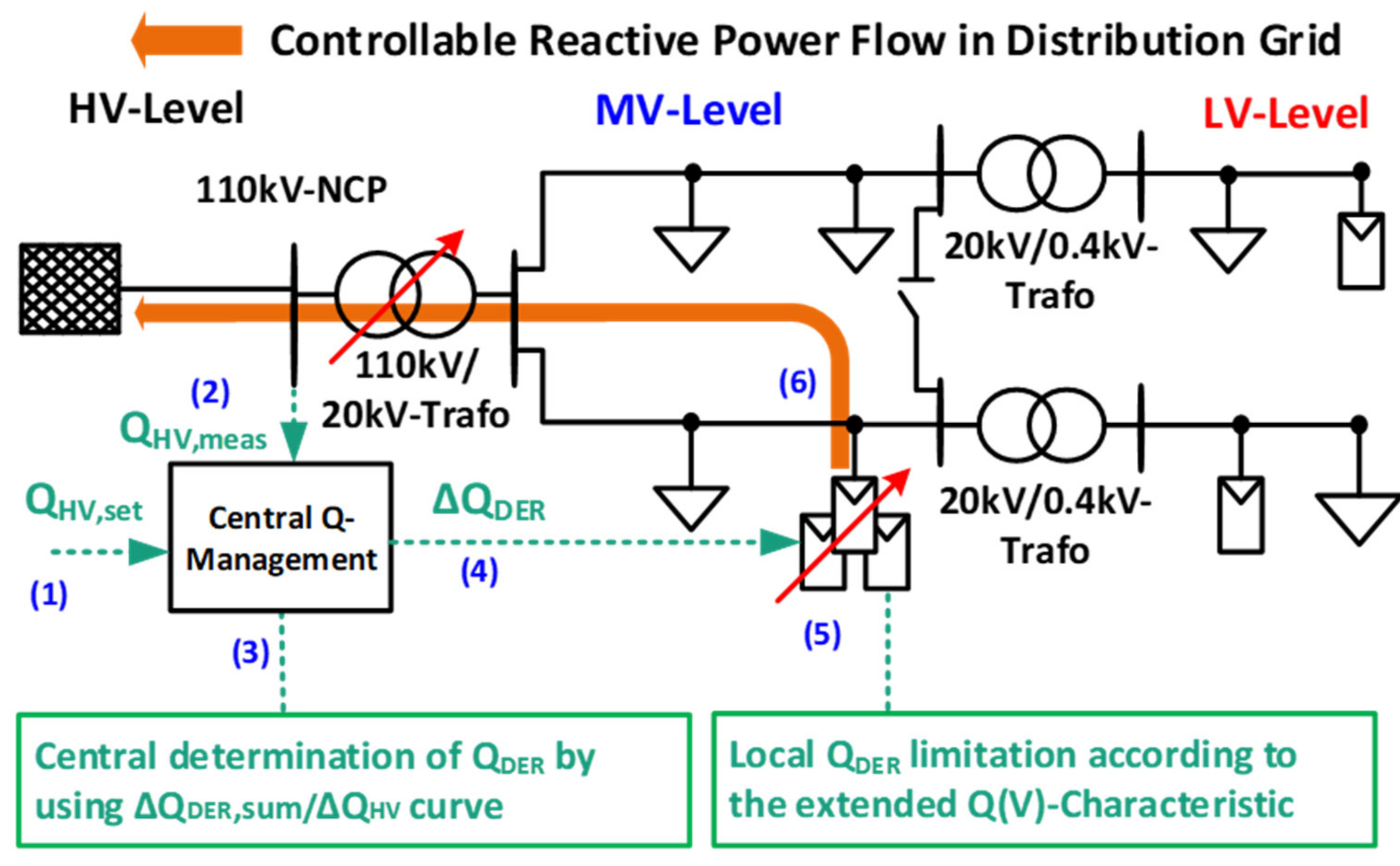

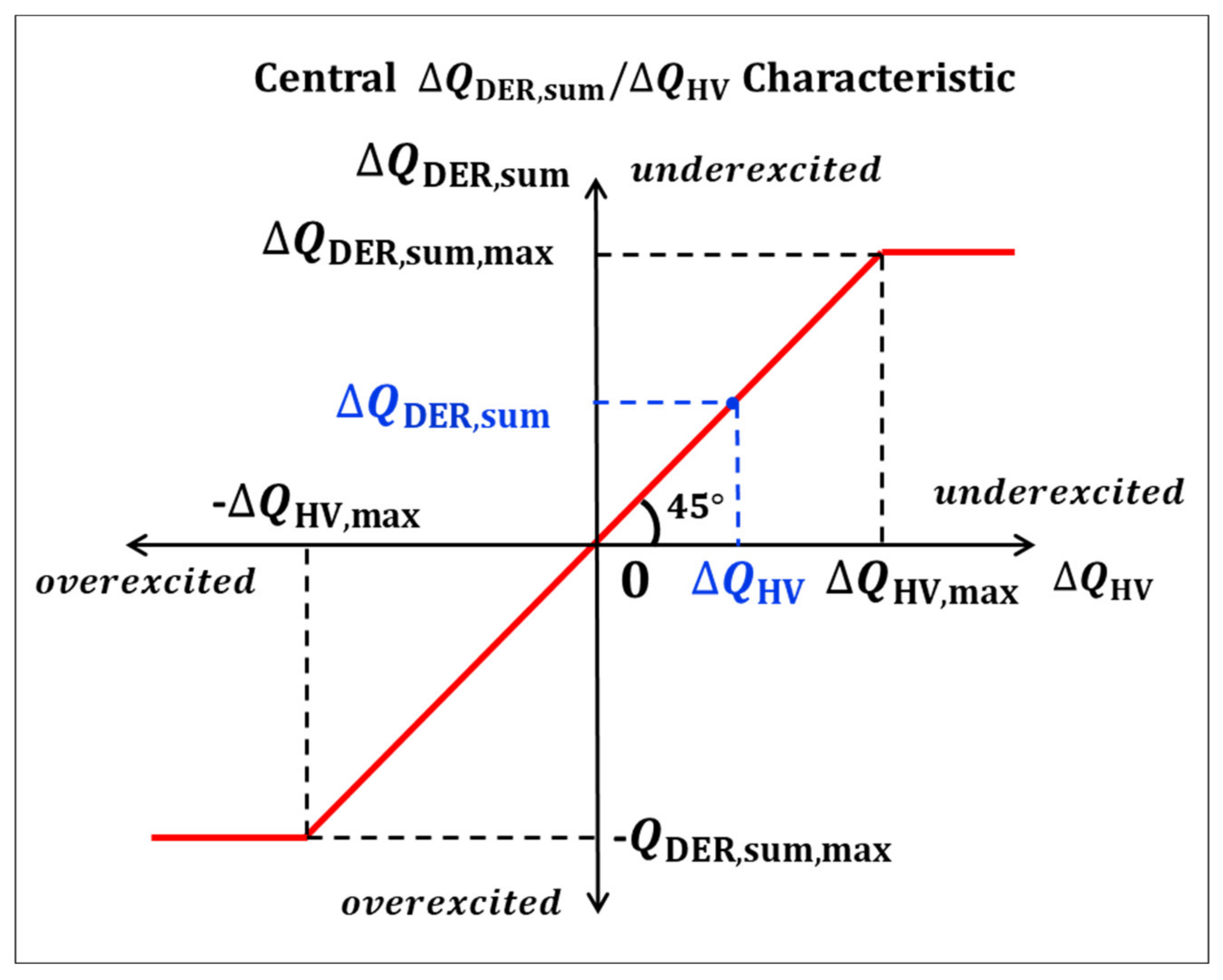
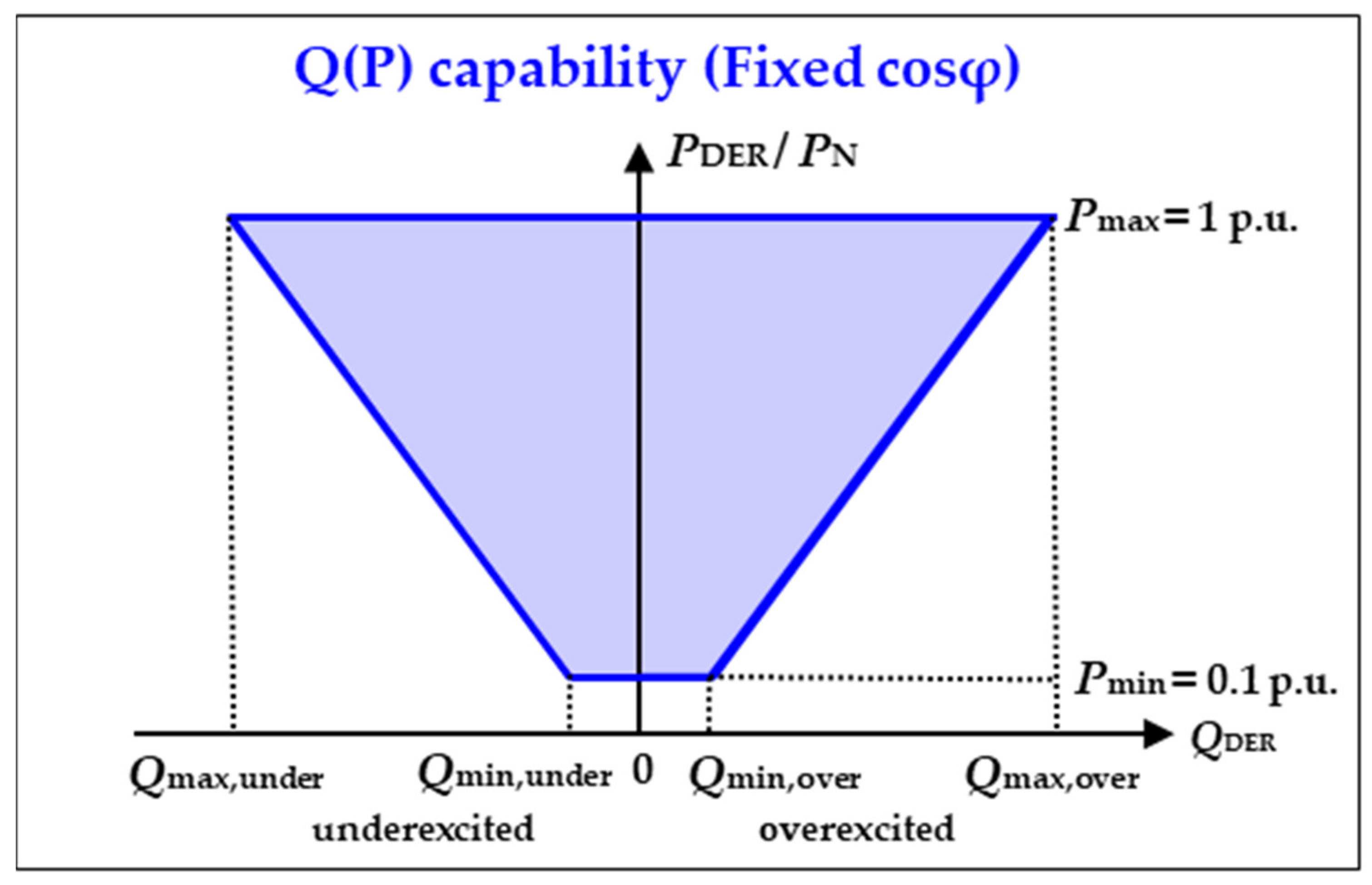




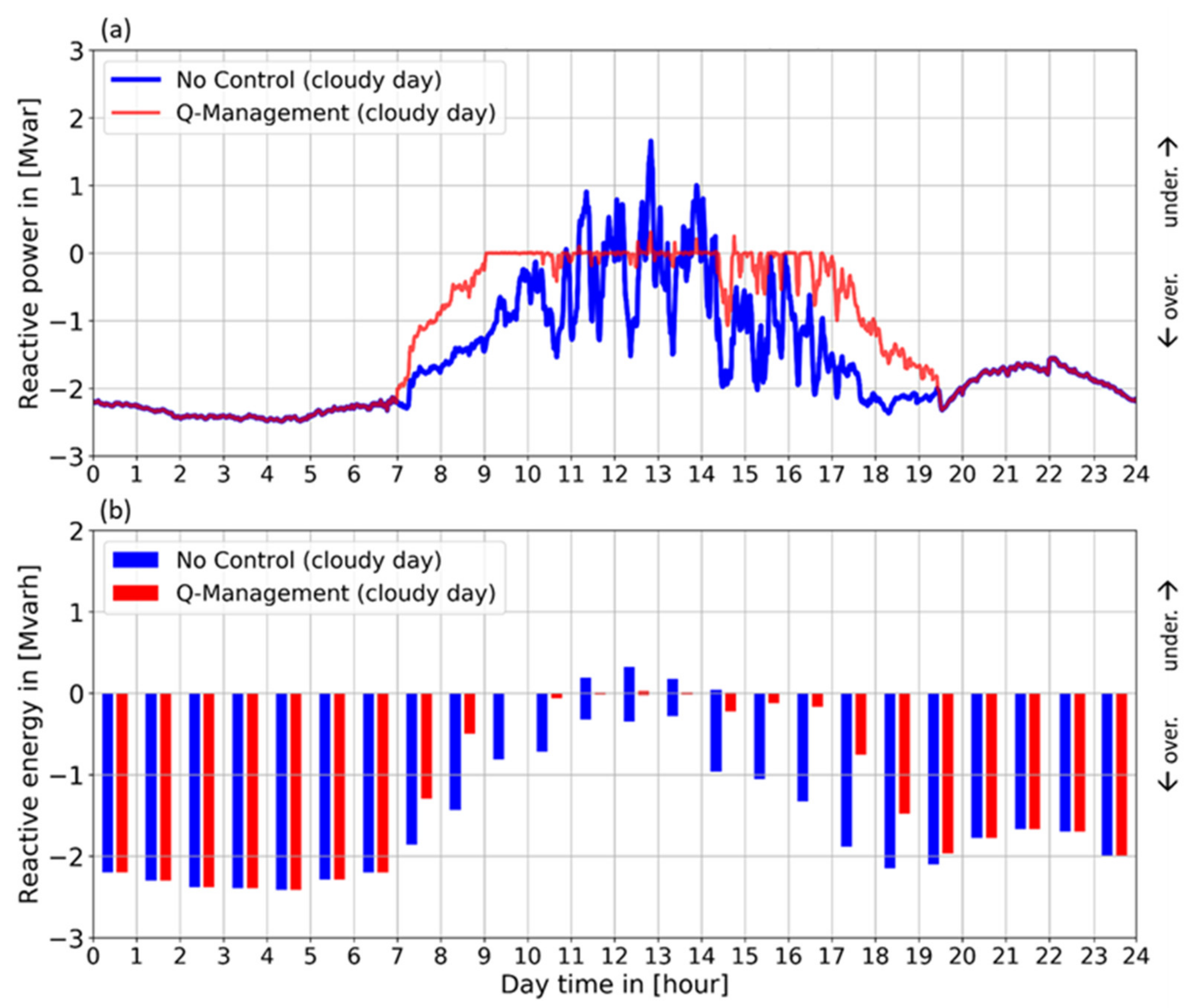
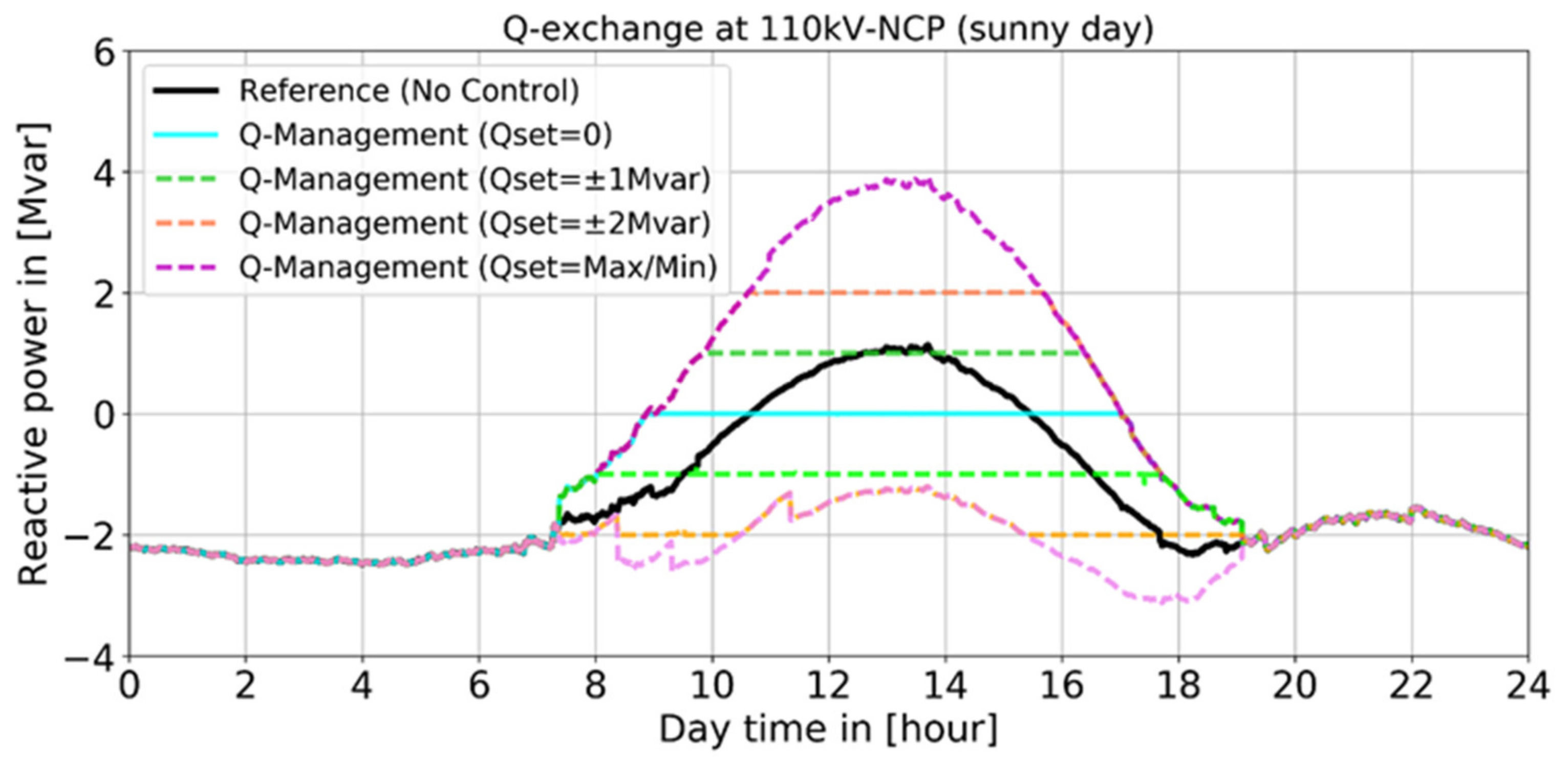
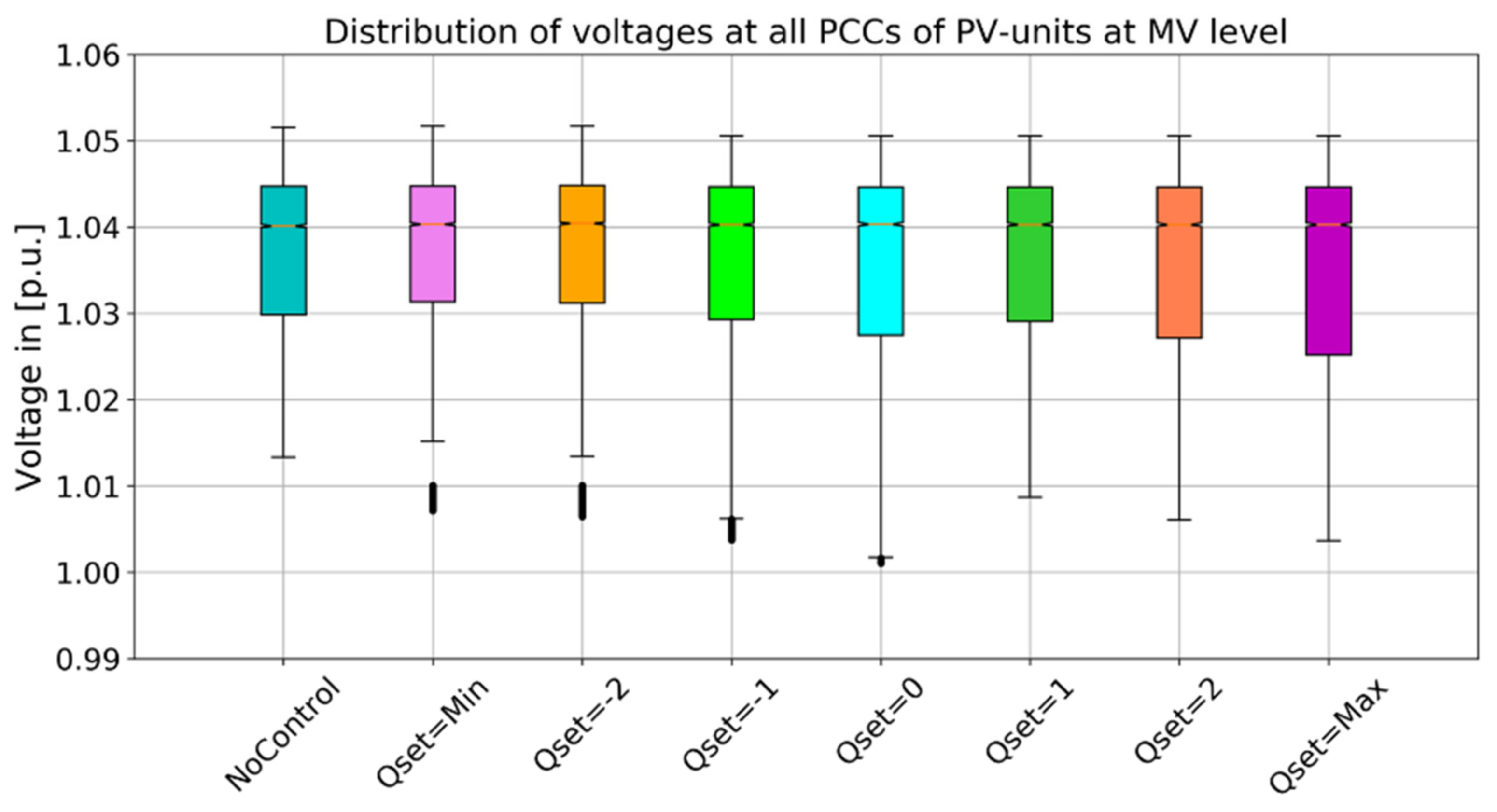

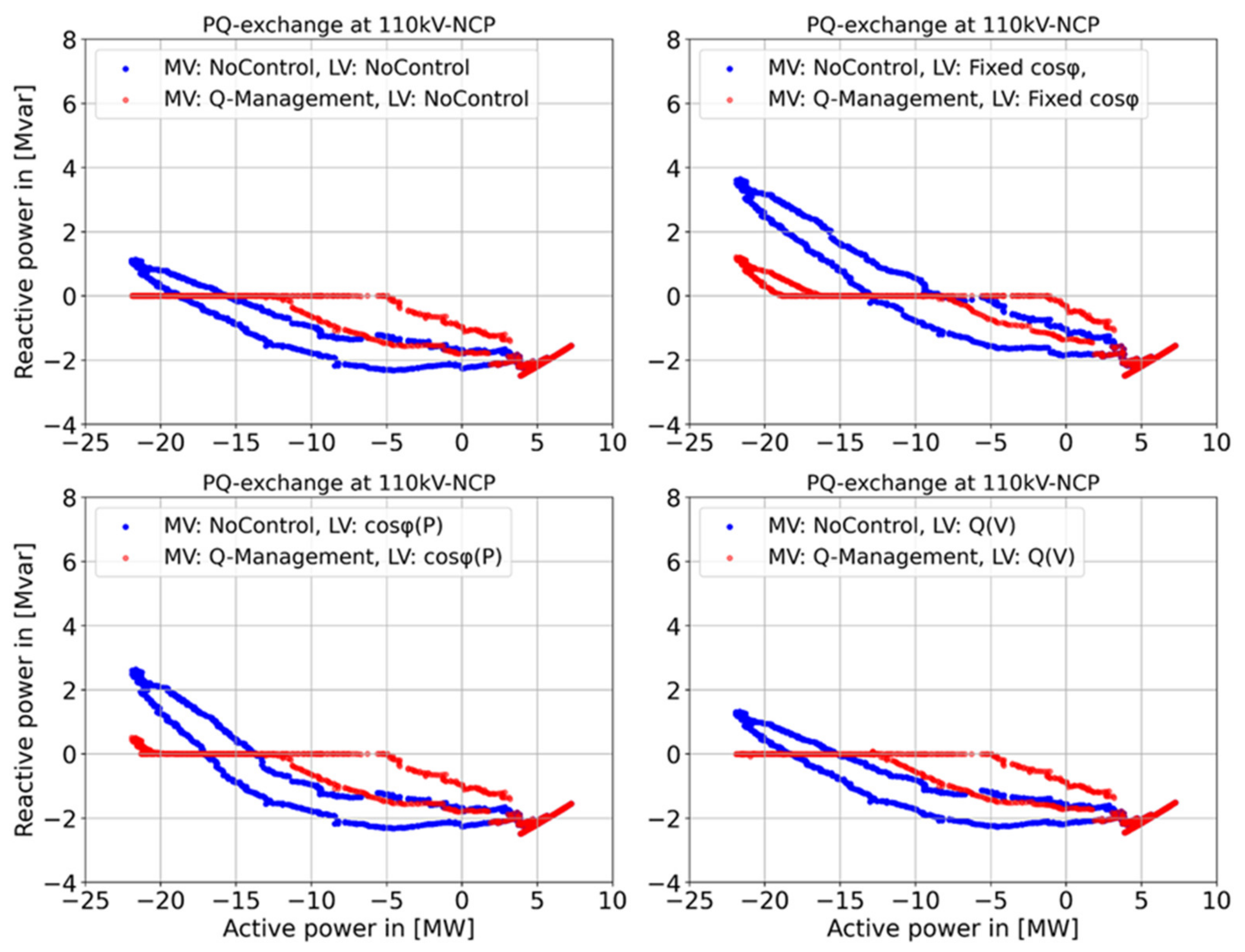

| Use Cases | fQmean | ||||||||||||||
|---|---|---|---|---|---|---|---|---|---|---|---|---|---|---|---|
| PV 1 | PV 2 | PV 3 | PV 4 | PV 5 | PV 6 | PV 7 | PV 8 | PV 9 | PV 10 | PV 11 | PV 12 | PV 13 | PV 14 | PV 15 | |
| Use Case 1 | 1.012 | 1.012 | 1.012 | 1.014 | 1.013 | 1.013 | 1.013 | 1.013 | 1.011 | 1.011 | 1.014 | 1.014 | 1.013 | 1.013 | 1.013 |
| Use Case 2 | 1.049 | 1.049 | 1.051 | 1.053 | 1.052 | 1.052 | 1.052 | 1.052 | 1.053 | 1.053 | 1.052 | 1.052 | 1.051 | 1.052 | 1.054 |
| Control | Parameter | Value | Description |
|---|---|---|---|
| Fixed | min | 0.95 | Pn < 13.8 kVA |
| 0.9 | Pn ≥ 13.8 kVA | ||
| (P) | min | 0.95 | Pn < 13.8 kVA |
| 0.9 | Pn ≥ 13.8 kVA | ||
| Q(V) | V1 | 1.05 p.u. | Parameter for local Q(V) control |
| V2 | 1.08 p.u. | ||
| Qmax | 0.31 Pn | Pn < 13.8 kVA | |
| 0.48 Pn | Pn ≥ 13.8 kVA |
| Scenarios | Transformer Control | Regulation | |
|---|---|---|---|
| Scenario 1 | Standard transformer control | Fixed | 0.95/0.9 |
| Scenario 2 | Standard transformer control | Q management | 0.95/0.9 |
| Scenario 3 | PF-dependent transformer control | Q management | 0.95/0.9 |
| Grid | Pn of all MV DER in MW | Standard (SD) Transformer Control | Power-Flow-Dependent (PF) Transformer Control | |||
|---|---|---|---|---|---|---|
| Vset in p.u. | V1 p.u. | P2 MW | V2 p.u. | P4 MW | ||
| Seebach | 13.1 | 1.02 | 1.04 | 0 | 1.0 | −20 |
| MV grid 1 | 10.4 | 1.04 | 10 | 0.99 | −20 | |
| MV grid 2 | 11.5 | 1.05 | 20 | 1.005 | −20 | |
| MV grid 3 | 14.7 | 1.04 | 0 | 1.01 | −12 | |
| MV grid 4 | 23.6 | 1.025 | 15 | 0.985 | −15 | |
Publisher’s Note: MDPI stays neutral with regard to jurisdictional claims in published maps and institutional affiliations. |
© 2021 by the authors. Licensee MDPI, Basel, Switzerland. This article is an open access article distributed under the terms and conditions of the Creative Commons Attribution (CC BY) license (https://creativecommons.org/licenses/by/4.0/).
Share and Cite
Wang, H.; Kraiczy, M.; Mende, D.; Stöcklein, S.; Braun, M. Application-Oriented Reactive Power Management in German Distribution Systems Using Decentralized Energy Resources. Energies 2021, 14, 4949. https://doi.org/10.3390/en14164949
Wang H, Kraiczy M, Mende D, Stöcklein S, Braun M. Application-Oriented Reactive Power Management in German Distribution Systems Using Decentralized Energy Resources. Energies. 2021; 14(16):4949. https://doi.org/10.3390/en14164949
Chicago/Turabian StyleWang, Haonan, Markus Kraiczy, Denis Mende, Sebastian Stöcklein, and Martin Braun. 2021. "Application-Oriented Reactive Power Management in German Distribution Systems Using Decentralized Energy Resources" Energies 14, no. 16: 4949. https://doi.org/10.3390/en14164949
APA StyleWang, H., Kraiczy, M., Mende, D., Stöcklein, S., & Braun, M. (2021). Application-Oriented Reactive Power Management in German Distribution Systems Using Decentralized Energy Resources. Energies, 14(16), 4949. https://doi.org/10.3390/en14164949






